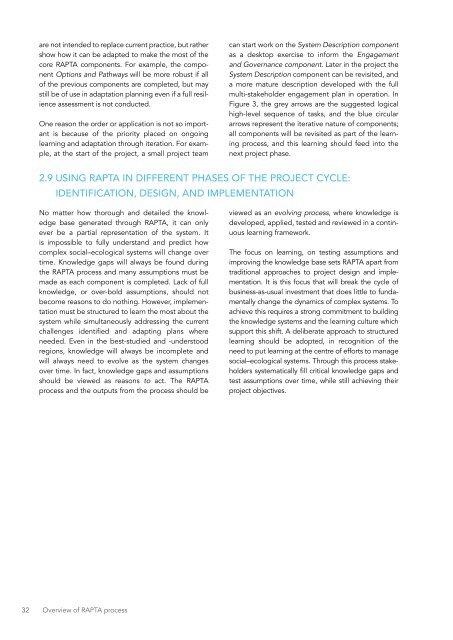DESIGNING PROJECTS IN A RAPIDLY CHANGING WORLD
srun3013fp1
srun3013fp1
You also want an ePaper? Increase the reach of your titles
YUMPU automatically turns print PDFs into web optimized ePapers that Google loves.
are not intended to replace current practice, but rather<br />
show how it can be adapted to make the most of the<br />
core RAPTA components. For example, the component<br />
Options and Pathways will be more robust if all<br />
of the previous components are completed, but may<br />
still be of use in adaptation planning even if a full resilience<br />
assessment is not conducted.<br />
One reason the order or application is not so important<br />
is because of the priority placed on ongoing<br />
learning and adaptation through iteration. For example,<br />
at the start of the project, a small project team<br />
can start work on the System Description component<br />
as a desktop exercise to inform the Engagement<br />
and Governance component. Later in the project the<br />
System Description component can be revisited, and<br />
a more mature description developed with the full<br />
multi-stakeholder engagement plan in operation. In<br />
Figure 3, the grey arrows are the suggested logical<br />
high-level sequence of tasks, and the blue circular<br />
arrows represent the iterative nature of components;<br />
all components will be revisited as part of the learning<br />
process, and this learning should feed into the<br />
next project phase.<br />
2.9 US<strong>IN</strong>G RAPTA <strong>IN</strong> DIFFERENT PHASES OF THE PROJECT CYCLE:<br />
IDENTIFICATION, DESIGN, AND IMPLEMENTATION<br />
No matter how thorough and detailed the knowledge<br />
base generated through RAPTA, it can only<br />
ever be a partial representation of the system. It<br />
is impossible to fully understand and predict how<br />
complex social–ecological systems will change over<br />
time. Knowledge gaps will always be found during<br />
the RAPTA process and many assumptions must be<br />
made as each component is completed. Lack of full<br />
knowledge, or over-bold assumptions, should not<br />
become reasons to do nothing. However, implementation<br />
must be structured to learn the most about the<br />
system while simultaneously addressing the current<br />
challenges identified and adapting plans where<br />
needed. Even in the best-studied and -understood<br />
regions, knowledge will always be incomplete and<br />
will always need to evolve as the system changes<br />
over time. In fact, knowledge gaps and assumptions<br />
should be viewed as reasons to act. The RAPTA<br />
process and the outputs from the process should be<br />
viewed as an evolving process, where knowledge is<br />
developed, applied, tested and reviewed in a continuous<br />
learning framework.<br />
The focus on learning, on testing assumptions and<br />
improving the knowledge base sets RAPTA apart from<br />
traditional approaches to project design and implementation.<br />
It is this focus that will break the cycle of<br />
business-as-usual investment that does little to fundamentally<br />
change the dynamics of complex systems. To<br />
achieve this requires a strong commitment to building<br />
the knowledge systems and the learning culture which<br />
support this shift. A deliberate approach to structured<br />
learning should be adopted, in recognition of the<br />
need to put learning at the centre of efforts to manage<br />
social–ecological systems. Through this process stakeholders<br />
systematically fill critical knowledge gaps and<br />
test assumptions over time, while still achieving their<br />
project objectives.<br />
32 Overview of RAPTA process


